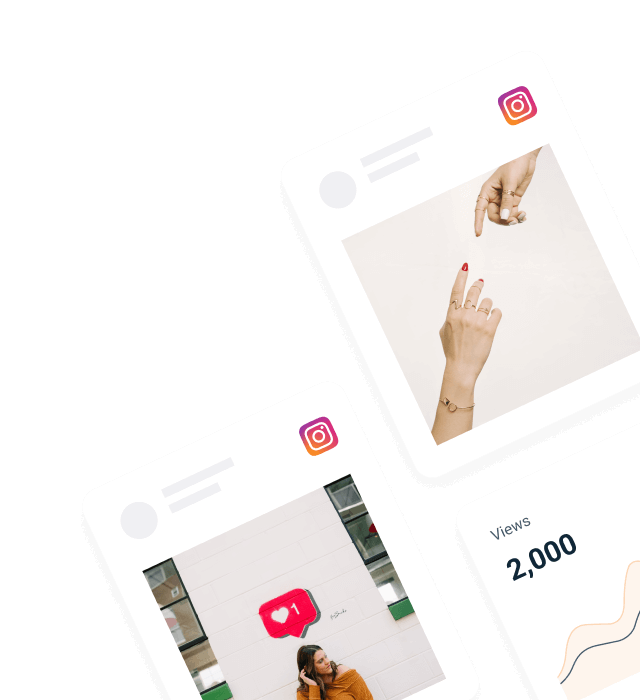Most agencies treat social media aggregation like decoration. A social wall on the event’s microsite. A TikTok carousel, discreetly placed below the fold. Maybe a hashtag feed during a product drop. They implement it, but not in a way that gives them or their customers any benefits.
All too often, social media aggregation is only done to tick the box of “showing” engagement from social media accounts. But that doesn’t actually do much for your social media strategy or your client’s marketing strategy, does it?
At Juicer, we’ve seen this pattern repeat time and time again. And we get it. Agencies are running after ten campaigns, for dozens of clients, and a handful of platforms. They are busy. It’s tempting to treat aggregation as the final touch. But that mindset is costing you—and your clients—results.
This guide is here to change that. We’ll walk you through why social media aggregation needs to be strategic, and how top-performing agencies are already doing this. We’ll give you plug-and-play tips for your next campaings, and show you what the right aggregation tool will do for you and your clients — far beyond campaigns.
Stop using social aggregation as a widget. It’s a strategy tool.
In the right hands, social aggregators are so much more than a tool that displays user-generated content. At their best, they’re infrastructure: built to distribute, amplify, and track content across multiple social media platforms, accounts, and formats.
Most agencies underuse social aggregation, or don’t see it’s strategic potential. Our team works with dozens of marketing teams who initially came to Juicer looking for a tool that can help with “social media display”—but what they really needed was campaign clarity, UGC distribution, and real-time visibility.
Used right, a social media aggregator can:
- Act as a single source of truth across channels
- Enhance audience targeting through strategic content display
- Save hours of reporting and asset curation through automation
The best-performing agencies use social media aggregator tools like Juicer as:
- A centralized content distribution system
- A modular social media dashboard for campaign visibility
- A lightweight, no-code way to scale client reporting
👉 Explore how Juicer supports agencies with real-time dashboards and white-labeled feeds.
Brand social aggregation: what nobody tells you about strategy
When agencies think about brand social aggregation, they often focus solely on displaying social media posts. But that’s like buying a Ferrari and then using it as a shopping cart.
The true value lies in how aggregation integrates with your entire campaign infrastructure. Consider this: every post your team creates has a lifespan. On most platforms, that lifespan is measured in hours, not days. But when strategically aggregated, that same social media content can deliver value for weeks or months.
Smart agencies aren’t just collecting branded content—they’re extending its lifecycle, multiplying its impact, and transforming one-off posts into lasting assets that strengthen your client’s social media presence.
For example, a fashion client’s Instagram Story might disappear after 24 hours on the platform. But when that same content is aggregated into their product pages, email campaigns, and in-store displays, its impact multiplies exponentially.

This approach transforms brand social aggregation from a nice-to-have feature into a critical campaign multiplier.
👉 Learn how Juicer helps you embed social proof at every stage of the funnel.
Common aggregation mistakes (and how to fix them)
If you’re managing multiple social media platforms across brand campaigns and using social walls as add-ons instead of strategy—this section is for you. These are the four mistakes we see most, and how to fix them without rebuilding your marketing plan.
Mistake 1: aggregating at the end instead of the beginning
Adding a feed at the end of a campaign limits its value. Aggregation is most powerful when it’s planned upfront as part of the content and amplification strategy.
Fix it: Build aggregation into the initial campaign architecture. Define which social media channels, hashtags, and branded content streams you’ll use—and how you’ll display and moderate them.
Mistake 2: using separate tools for every client
Juggling multiple aggregator tools across clients slows teams down and breaks process consistency.
Fix it: Consolidate your workflows with a platform that supports multiple feeds, custom styling, and client-specific dashboards. This makes it easier to manage operations and onboard new brands.
Mistake 3: no moderation or filtering in place
Without filters, feeds can display irrelevant or off-brand content. This creates risk, especially during time-sensitive launches or when UGC is pulled from public hashtags.
Fix it: Use advanced moderation features: auto-ban keywords, manual approval queues, and source-specific filtering (e.g. only verified creators or approved influencers).
Mistake 4: treating display as the end goal
If you’re only using aggregators to make a homepage prettier, you’re missing the bigger picture. Social content should guide users, signal trust, and increase conversions.
Fix it: Use feeds to support funnel progression—embed them on product pages, email newsletters, or campaign wrap-ups. And track what’s working.
Audience engagement: the missing link in most campaign strategies
Here’s a hard truth: most agencies measure engagement within platforms, not across them. They track likes, comments, and shares—but completely miss how engagement should flow between touchpoints.
This siloed approach creates a critical blind spot. Your audiences don’t experience campaigns in silos. They move between platforms, channels, and owned media constantly. Your engagement strategy should reflect this reality.
Strategic social aggregation bridges this gap by creating clear pathways for engagement to flow from social platforms to owned media and back again. Instead of isolated engagement metrics, you get a holistic view of how audiences interact with campaign content across their entire journey.

Marketing campaigns that leverage aggregation from day one
Smart campaigns aren’t just using social aggregation—they’re built around it. Here’s how leading agencies integrate aggregation from campaign inception:
Pre-launch: build the collection infrastructure
Before creative development, top agencies establish:
- Campaign-specific hashtags and tracking parameters
- Collection points across owned and earned channels
- Moderation workflows and approval processes
- Display locations and content routing rules
This foundation ensures that when content starts flowing, it’s immediately captured, curated, and deployed effectively.
Launch phase: dynamic content activation
During launch, strategic aggregation enables:
- Real-time showcase of early adopters and influencers
- Curation of high-performing content across touchpoints
- Quick identification and amplification of unexpected wins
- Social proof that converts campaign awareness into action
Rather than waiting to collect content after the fact, this approach turns aggregation into an active campaign accelerator.
Post-launch: sustained momentum and reuse
After the initial push, aggregation supports:
- Content libraries for ongoing campaign extensions
- Performance analysis to inform future creative
- User-generated assets for retargeting and retention
- Case studies built from authenticated results
This extended lifecycle transforms campaigns from time-limited events into ongoing content engines.
Hashtag campaigns reimagined through strategic aggregation
Most agencies run hashtag campaigns like it’s still 2015. They pick a clever tag, promote it heavily, then scramble to track results across disconnected platforms. The outcome? Lost content, missed opportunities, and incomplete reporting.
Strategic aggregation changes this dynamic completely. Instead of chasing content after it’s created, you build a system that captures, curates, and deploys it automatically. This shift transforms hashtag campaigns from chaotic sprints into structured, measurable programs.
The difference is particularly stark for multi-platform campaigns. Without proper aggregation, you’re essentially running separate campaigns on each platform, with separate workflows and metrics. With strategic aggregation, these become a single, coherent initiative with unified visibility and reporting.
Take a recent festival campaign that used our system. Instead of manually screenshotting the best posts, their team:
- Set up platform-specific feeds that all fed into one master dashboard
- Created moderation queues for different content types
- Deployed curated content to event screens, the website, and sponsor areas
- Generated post-event reports with authenticated content and engagement metrics
All from one system, with minimal manual intervention. That’s what hashtag campaigns should look like in 2025—organized, efficient, and measurable.
👉 Check our guide for successful hashtag campaigns
Community engagement that drives measurable results
Community engagement isn’t just about fostering warm feelings—it’s about creating measurable business impact. Strategic social aggregation transforms community interactions from fuzzy metrics into concrete results.
The key is connecting social engagement directly to campaign objectives. Instead of treating community interactions as standalone activities, leading agencies use aggregation to:
- Identify and elevate community advocates through curated feeds
- Transform community content into conversion assets on product pages
- Provide social proof at critical decision points in the customer journey
- Build community milestones into campaign reporting and client deliverables
This approach makes community engagement tangible for clients who care about results, not just reach. By integrating community engagement into your campaign infrastructure through strategic aggregation, you transform it from a nebulous concept into a concrete business driver.
How to boost engagement with strategic feed placement
Where you place your social feeds matters as much as what’s in them. Most agencies default to predictable locations: the bottom of landing pages or dedicated “social” tabs that get minimal traffic. This placement treats social content as an afterthought, not a strategic asset.
Forward-thinking agencies are completely rethinking feed placement based on customer journey mapping. They’re identifying critical moments where social proof can tip the scales and positioning aggregated content precisely at those points.
Here are strategic placements that drive measurable results:
Product decision points
Embed curated feeds directly alongside product information, showing real users with the product in context. This works particularly well for fashion, beauty, and lifestyle brands where seeing products “in the wild” builds confidence.
Conversion thresholds
Place social proof at moments of hesitation—like checkout pages, pricing tables, or form submissions. Seeing others who’ve taken the same step reduces friction and improves follow-through.
Credibility reinforcement
Position expert and influencer content near complex or technical information to build trust. This works especially well for B2B campaigns or products with longer consideration cycles.
Community belonging signals
Showcase user content in membership areas, exclusive offers, or loyalty programs to strengthen community identity and encourage deeper participation.
The key principle: place social content where it solves a specific problem in the user journey, not where it’s conventionally expected. This strategy turns aggregation from passive display into an active conversion tool.

Content curation: the secret weapon of high-performing feeds
Most agencies approach content curation reactively—filtering out inappropriate content and hoping what remains looks cohesive. This passive approach misses the strategic potential of purposeful curation.
Smart curation isn’t just about what you exclude—it’s about deliberately shaping narratives, highlighting specific aspects of campaigns, and creating content collections that serve distinct objectives.
Here’s how strategic curation transforms social aggregation:
Narrative-driven collections
Instead of chronological feeds, create curated collections that tell specific stories:
- Product transformation journeys
- Behind-the-scenes campaign moments
- Customer feedback and problem-solving sequences
- Before/after progressions
Objective-specific feeds
Curate different feeds for different campaign goals:
- Conversion-focused feeds highlighting customer results
- Awareness feeds showcasing creative campaign interpretations
- Trust-building feeds featuring expert endorsements
- Community feeds emphasizing participation and belonging
Dynamic curation that adapts
The most sophisticated approach uses performance data to continuously refine curation:
- Promoting highly engaging content to prominent positions
- Adjusting content mix based on conversion impact
- Rotating fresh content while preserving top performers
- A/B testing different curation approaches to optimize results
By approaching curation strategically, you transform social aggregation from passive collection into purposeful communication that directly supports campaign objectives.
Content creation informed by aggregation insights
Most agencies create social content in a vacuum, then measure performance after the fact. This reactive approach leads to inconsistent results and missed opportunities. Strategic aggregation flips this model by providing real-time insights that inform ongoing content creation.
When your aggregation system captures content across platforms, sources, and campaigns, it becomes an invaluable source of creative intelligence. Here’s how leading agencies use aggregation to guide content creation:
Identifying high-performing formats
Aggregated feeds quickly reveal which content formats drive engagement across platforms:
- Do carousel posts consistently outperform single images?
- Are certain video lengths more effective than others?
- Do posts with specific visual components get more interaction?
- Which caption styles drive the most meaningful engagement?
These patterns help teams focus creative resources on formats with proven impact.
Spotting emerging trends early
Comprehensive aggregation surfaces trends before they become obvious:
- New hashtags gaining momentum in your space
- Visual styles resonating with specific audience segments
- Messaging approaches that cut through platform noise
- User behavior shifts across platforms
Identifying these trends early gives your content a competitive edge.
Refining voice and positioning
Seeing all content side-by-side highlights strengths and weaknesses in brand voice:
- Does your tone remain consistent across platforms?
- Which voice elements resonate most strongly with audiences?
- Are there disconnects between brand and user language?
- Which positioning aspects generate the most authentic responses?
These insights help refine messaging for greater impact and consistency.
By using aggregation as an intelligence tool, not just a display mechanism, you create a virtuous cycle where better insights lead to better content, which generates more valuable data for aggregation.
What agencies should expect from a modern social media aggregator
Social aggregators have evolved. The best ones aren’t just collecting content—they’re enabling strategic decisions. If your current solution can’t help you track engagement, curate content per brand, or support multiple sites, it’s time to upgrade.
Here’s what the most forward-thinking agencies look for when choosing a platform:
| Capability | Why It Matters |
|---|---|
| Multi-feed dashboards | Run multiple client campaigns in a single system |
| White-label styling | Seamlessly blend feeds into each brand’s identity |
| Platform & hashtag filtering | Control visibility by source, relevance, or campaign tags |
| Real-time updates | Ideal for live events, flash campaigns, and seasonal drops |
| Manual + auto moderation | Protect brand integrity and avoid inappropriate content |
| Analytics + reporting tools | Extract insights and deliver real value to clients |
| CMS-agnostic embed options | Works across WordPress, Webflow, Shopify, and custom sites |
How we’d manage overlapping campaigns across multiple clients
Let’s walk through how our team would approach a real-world situation many agencies face: multiple client campaigns running at once, with different goals and content types.
Scenario:
- Client A: launching a new product with influencer content
- Client B: short-term hashtag challenge on Instagram + TikTok
- Client C: sponsored event with live screens and a branded hashtag
- Client D: long-term UGC collection for brand awareness
- Client E: localized campaign across multiple languages
Our approach using Juicer:
- Build five feeds inside one agency dashboard
- Apply platform-specific filters and hashtag rules per brand
- Customize feed styling to match brand kits
- Embed feeds in key locations: homepages, LPs, event screens, digital signage
- Apply content moderation for event and influencer feeds; auto for evergreen content
- Use brand tags to organize content from different social media walls
- Create fine-tune filtering options for each client based on their right audience
Note that Juicer is being built out as we speak, as social media and campaigns are ever changing. For instance, we’re working on features that let you automate custom reports with insights on post volume, engagement, top contributors, platform split, and more. If you have any other wishes or suggestions, always get in touch with our team.
Outcome: Clean workflows, consistent quality, and faster campaign execution that helps potential customers engage with your client’s content in a single location.
Why every agency should standardize how it aggregates content
The agencies that scale best have one thing in common: repeatability. Aggregation should not be reinvented every time. It should be built once, then used everywhere.
Here’s what standardization unlocks:
- Reduced onboarding time for new brands
- Faster campaign launch windows
- Cleaner reporting and performance visibility
- Less dependency on dev or design
- Higher client satisfaction (they actually see the work happening)
We believe aggregators should feel like infrastructure: reliable, scalable, and quietly doing the heavy lifting behind great campaigns. If you want exactly that, check out our plans and find what works for your agency.
FAQ:
Social media aggregation for agency campaigns
Q: How do we identify the right target audience for each social media feed?
A: Don’t think of feeds as something that will work universally. Each feed must target a specific segment of your client’s audience based on where they are in the journey. Look at your highest-engaging content on other social media, then develop feeds that address specific pain points or requirements. The best feeds don’t try to appeal to everyone—they address specific issues for specific groups.
Q: Which social media networks deliver the best content for aggregation?
A: This isn’t about which platforms are “best”—it’s about where your client’s specific audience creates the most valuable content. For visual products, Instagram and TikTok typically deliver high-quality content. For B2B, LinkedIn and Twitter provide more detailed, shareable information. The idea is to focus on 2-3 sites where your community is most active rather than diluting effort across many social media sites.
Q: How can we effectively showcase user-generated content without overwhelming our client’s brand voice?
A: Curation is everything. Set clear guidelines for what makes UGC “on brand” before you start collecting. Develop a moderation framework that balances authenticity with brand consistency. The most effective approach is creating specific content categories (e.g., product use, transformation stories, expert endorsements) and defining what “great” looks like for each—then moderating against those standards.
Q: Our clients want to pull from different social media platforms but worry about inconsistent quality. How do we solve this?
A: This is where strategic filtering and moderation make all the difference. Instead of displaying everything, create platform-specific rules: higher engagement thresholds for Twitter, visual quality filters for Instagram, or verified-only settings for certain hashtags. The goal isn’t maximum content—it’s maximum impact. A single, carefully curated feed will always outperform multiple platforms dumping unfiltered content.
Q: How do the best social media aggregators handle content from multiple platforms without creating a disjointed experience?
A: Top aggregators like Juicer don’t just collect—they normalize. This means standardizing how different content types display, ensuring consistent engagement metrics across platforms, and providing unified moderation tools. Look for ones that provide customizable templates that keep the brand look intact while expressing each platform’s special value. The aim is to create a cohesive experience that doesn’t seem like a random assortment of posts, but rather well-planned.
Q: How much time should we invest in customizing how we display content from social feeds?
A: This isn’t about hours spent—it’s about strategic alignment. Start by mapping exactly where feed content will appear in the customer journey. For conversion-focused placements (like product pages), invest heavily in customization that emphasizes social proof. For awareness content (like blog post embeds), lighter customization is fine. The key question isn’t “how much time” but “how critical is this touchpoint to conversion?”
Q: What kind of actionable insights should we be extracting from our aggregated feeds?
A: Move beyond vanity metrics. Focus on insights that drive decisions:
- Which content formats drive the highest engagement-to-conversion ratio
- Which user segments create the most valuable UGC
- What messaging resonates across platforms vs. what’s platform-specific
- How rapidly content themes rise and fall (content half-life)
- Which brand advocates consistently produce high-quality content
Real-time analytics should inform your content strategy, not just measure it after the fact.
Q: How do we decide between free plans and paid plans for social media aggregation?
A: Free plans are fine for testing, but they’re rarely sufficient for agency work. Most free options limit refresh rates, restrict customization, or insert branding that competes with your client’s. Consider what drives actual value: Is it the single stream of content, or is it the detailed analytics, custom styling, and moderation tools that make that content convert? Agencies need infrastructure, not toys—and that typically means investing in a solution with proper support.
Q: How can we use social aggregation to help clients spot the latest trends in their industry?
A: Treat your aggregation system as an information technology asset, not just a display tool. Set up separate “trend-watching” feeds that gather content from thought leaders, competitors, and industry hashtags. Create weekly reports highlighting emerging patterns, terminology shifts, or visual trends. The best agencies don’t just react to trends—they spot them early by systematically monitoring the social landscape through strategic aggregation.




